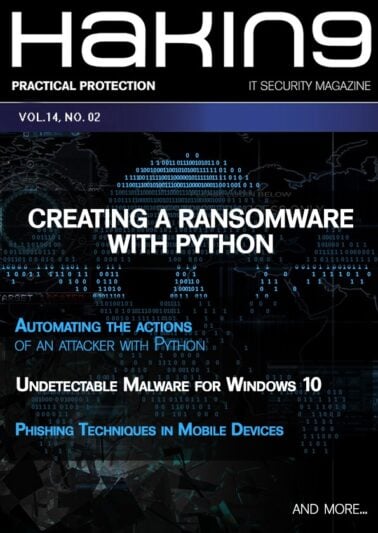No products in the cart.
Hacking with ChatGPT
$33.00
116 items sold
Get the access to all our courses via Subscription
Subscribe
Download
File h9-hacking-with-chatgpt - preview.pdf
Dear Readers,
With AI gaining in popularity, we have decided to talk about its increasing importance in the cybersecurity world. Knowing how AI can change the work of a specialist, both harder and easier, is clearly needed. So we decided to make “Hacking with ChatGPT” the edition’s theme and main topic. Grab a hot beverage (or a cold one!) and enjoy the content provided by our authors and our team!
Right at the beginning, we will talk about AI-driven cybersecurity methods, with the article explaining how AI can be used in defensive measures. “AI-driven shields designed for cyber warriors” talks about the reliance that AI will have on new defensive cybersecurity methods.
Then we move to another article from one of our returning authors explaining how cybersecurity will be implemented in the Army, creating a new type of special forces. “Modern Special Forces Of The Future (Air, Land, Sea, Cyber)” talks about the need to accept that, with the progress of technology, this will create a shift in military doctrine and internal politics.
In the next article, our author decided to talk about the Security of Privileged Access. It talks about how administrative access can be used to harm the organization, especially when misused. Therefore, it’s essential that organizations properly control and monitor it, to nullify any possible security risks.
In another article, you will learn about insider threats. “Insider Threats: The Hidden Danger Within Your Organization and How to Safeguard Against Them” explains how an employee or a contractor may cause an organization potential harm or damage. Access to a company’s resources may be used for malicious purposes, for example, theft of sensitive data, sabotaging systems, espionage and even financial fraud.
Next, we jump back to AI in cybersecurity. The article “Impact of Artificial Intelligence on Cybersecurity” talks about just that. The author decided to look at the potential AI has in both offensive and defensive measures in cybersecurity. The cyberworld will experience change because of AI’s growing importance; even now we can see the ways AI impacts security.
We’ll also talk a bit about Hashcat! This tool allows for password cracking. “Hashcat: A Beginner’s Guide” is just that. You’ll learn how to use Hashcat for password hashing. This useful knowledge might help you better understand the security of passwords and ways they can be tested.
ChatGPT gained a lot of popularity, therefore, we are posing questions about how it will change the Cybersecurity world. Our author looked at it from the perspective of a Pentester. “When PT in ChatGPT refers to Penetration Testing” explains how pentesters can use ChatGPT to help in their work.
In the next article, our authors talk about Kubernetes, a powerful tool for managing cloud workloads. “Bypassing and Securing Kubernetes Ingress Network Policies” is a great introduction to ingress network policies, which are an important tool for securing a Kubernetes cluster.
OSINT is a great and useful set of techniques used in cybersecurity. The article “OSINT: A Thoughtfulness About the Advantages and Disadvantages of this Technique” talks about just that. All of the great things OSINT can do, but it also looks at the issues it can create.
We end this edition with a bit of Python coding! “Secure Coding Practices in Python: Best Practices for Avoiding Common Vulnerabilities” explains how to keep your Python code secure. Every programmer needs to protect their code, even though Python is a high-level language it remains vulnerable to outside threats.
We hope the articles attached will provide you with useful and essential knowledge for your interests.
Have fun reading this edition’s content!
Jacek Stankiewicz and the Hakin9 Editorial Team
TABLE OF CONTENTS
When PT in ChatGPT refers to Penetration Testing
Gabriele Bondo
Everybody does it. Everyone perceives that the utilisation of AI can benefit the Penetration Testing process. Everyone talks about it. This reminds us of when a few years ago, people spoke about "cloud" to disguise the fog in their brains. One thing for sure, there is a certain amount of hype about AI nowadays.
Hashcat: A Beginner's Guide
Aditya Kattimani
Hashing is a process of converting data of arbitrary size into a fixed-size output, using a mathematical function. In the context of password security, hashing is used to protect user passwords by converting them into a hashed value before storing them in a database. This makes it much harder for the attackers to retrieve the original password if the database is compromised. And to add on that, hashing is an irreversible process (one-way process).
Insider Threats: The Hidden Danger Within Your Organization and How to Safeguard Against Them
Abhinav Porwal
In today's digital age, information is power. With the increasing use of technology and the internet in the workplace, organizations are at a greater risk of insider threats than ever before. Insider threat refers to the potential harm or damage that an individual, whether an employee or a contractor, can cause to an organization by using their authorized access to the company's resources for malicious purposes.
A.I.-driven shields design for cyber warriors.
Lochana Koralage
Since more private data is stored and transmitted digitally, cybersecurity has emerged as a pressing concern in the Internet Age. Network intrusions can cause devastating financial losses, damage to a company's reputation, and even, in the worst-case scenario, physical harm to individuals. Any firm, from a one-person operation to a Fortune 500 conglomerate, is vulnerable to cyber-attacks. So, it is crucial to safeguard your company against the myriad internet threats that exist by implementing effective cybersecurity measures.
Impact of Artificial Intelligence on Cybersecurity
Robert Searcy
Current advances in Artificial Intelligence (AI) are widely impacting the cybersecurity industry. Companies are increasing budgets for cybersecurity engineers with experience building AI toolsets to combat Offensive AI. Bad actors have found ways AI can morph its attack pattern, which has led to almost undetectable attacks. Attackers are leveraging AI to increase the efficiency of many common attack methods that companies face. These attacks have increased in impact and are now becoming life-threatening.
Modern Special Forces Of The Future (Air, Land, Sea, Cyber)
Lochana Koralage
The world is becoming more complicated and unpredictable, which means that the world's armed forces need to evolve in order to address the new challenges and threats they face. The development of future forces of the next generation calls for a multi-pronged strategy that takes into account developments in technology, new security challenges, shifting patterns in international politics, and shifts in military doctrine.
Security of Privileged Acces
Opinder Singh
Privileged access allows individuals to perform actions that could potentially harm the organization if misused, it is essential to control and monitor it carefully. It can pose significant security risks if not adequately managed. Organizations must, therefore, take appropriate measures to ensure the security of privileged access.
Bypassing and Securing Kubernetes Ingress Network Policies
Kavyashree Ramesh, Tousif Khazi, Tejas Jaiswal
Ingress network policies are an important tool for securing a Kubernetes cluster, but it is possible for an attacker to bypass a network ingress policy if they are able to find a weakness or vulnerability in the policy's implementation or if they are able to exploit a weakness in the network infrastructure itself.
OSINT: A Thoughtfulness About the Advantages and Disadvantages of this Technique
Mariana Gouveia
OSINT, acronym word from English Open Source Intelligence, refers to a set of techniques about collection of data of interest, raw at first sometimes, obtained through publicly available sources such as social networks, newspapers, magazines, blogs, forums, publications and commercial data, for example, that after further analysis, selection, specialized correlation and processing becomes information and knowledge of intelligence.
Secure Coding Practices in Python: Best Practices for Avoiding Common Vulnerabilities
Sarang S. Babu
Developers should practice the following top Python security programming practices to ensure the least vulnerability. No matter how little the application is or how skilled the developers who created it are, there is always a chance that a security flaw might be used against it. Security risks are not invulnerable to Python. Secure coding best practices must be applied to lower the danger of attacks.
Only logged in customers who have purchased this product may leave a review.





Reviews
There are no reviews yet.